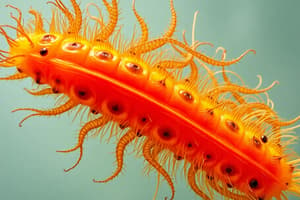Podcast
Questions and Answers
Which level of classification comes immediately after the kingdom level?
Which level of classification comes immediately after the kingdom level?
- Phylum (correct)
- Order
- Genus
- Family
Which component is NOT considered a biotic factor in an ecosystem?
Which component is NOT considered a biotic factor in an ecosystem?
- Microorganisms
- Animals
- Soil (correct)
- Plants
What best describes the term 'genetic diversity'?
What best describes the term 'genetic diversity'?
- The overall biomass of an ecosystem.
- The variety of ecosystems within a geographical area.
- The number of species in a given area.
- The variability of genes within species. (correct)
What is the primary function of mitochondria in eukaryotic cells?
What is the primary function of mitochondria in eukaryotic cells?
In which type of ecosystem would you primarily find deserts?
In which type of ecosystem would you primarily find deserts?
Which of the following correctly describes eukaryotic cells?
Which of the following correctly describes eukaryotic cells?
What is the role of decomposers in an ecosystem?
What is the role of decomposers in an ecosystem?
Which level of biological organization consists of groups of similar cells performing a common function?
Which level of biological organization consists of groups of similar cells performing a common function?
What is primarily enhanced by biodiversity in ecosystems?
What is primarily enhanced by biodiversity in ecosystems?
Which domain includes organisms with prokaryotic cells that are often extremophiles?
Which domain includes organisms with prokaryotic cells that are often extremophiles?
Flashcards are hidden until you start studying
Study Notes
Classification Of Life
- Taxonomy: The science of naming and classifying organisms.
- Hierarchy of Classification:
- Domain
- Kingdom
- Phylum
- Class
- Order
- Family
- Genus
- Species
- Three Domains:
- Bacteria: Prokaryotic, unicellular organisms.
- Archaea: Prokaryotic, often extremophiles.
- Eukarya: Organisms with eukaryotic cells (includes plants, animals, fungi, and protists).
Biodiversity
- Definition: Variety of life forms in a given habitat or ecosystem.
- Levels of Biodiversity:
- Genetic Diversity: Variability of genes within species.
- Species Diversity: Variety of species within a community.
- Ecosystem Diversity: Variety of ecosystems within a geographical area.
- Importance:
- Enhances ecosystem productivity and resilience.
- Provides resources (food, medicine).
- Supports ecosystem services (pollination, nutrient cycling).
Ecosystems
- Definition: A community of living organisms and their physical environment interacting as a system.
- Components:
- Biotic Factors: Living components (plants, animals, microorganisms).
- Abiotic Factors: Non-living components (water, soil, climate).
- Types of Ecosystems:
- Terrestrial (forests, grasslands, deserts).
- Aquatic (freshwater, marine).
- Energy Flow:
- Producers (autotrophs) convert sunlight to energy.
- Consumers (heterotrophs) obtain energy by consuming others.
- Decomposers recycle nutrients back into the ecosystem.
Cell Structure
- Basic Unit of Life: Cells are the smallest units that can carry out all life processes.
- Types of Cells:
- Prokaryotic Cells: No nucleus, smaller, simpler structure (e.g., bacteria).
- Eukaryotic Cells: Have a nucleus, larger, more complex (e.g., plant and animal cells).
- Key Organelles in Eukaryotic Cells:
- Nucleus: Contains DNA.
- Mitochondria: Powerhouse of the cell, energy production.
- Ribosomes: Protein synthesis.
- Endoplasmic Reticulum: Protein and lipid synthesis.
- Golgi Apparatus: Modifies and packages proteins.
Biological Organization
- Levels of Organization:
- Molecules: Chemical building blocks of life.
- Cells: Basic structural and functional units.
- Tissues: Groups of similar cells performing a common function.
- Organs: Structures composed of different tissues working together.
- Organ Systems: Groups of organs that perform related functions.
- Organisms: Individual living entities.
- Populations: Groups of the same species in a given area.
- Communities: Interactions among different populations.
- Ecosystems: Communities plus their physical environment.
- Biosphere: The global sum of all ecosystems; zones of life on Earth.
Classification Of Life
- Taxonomy involves naming and classifying organisms systematically.
- Hierarchical classification includes Domain, Kingdom, Phylum, Class, Order, Family, Genus, and Species.
- Three domains of life:
- Bacteria: Unicellular, prokaryotic organisms lacking a nucleus.
- Archaea: Prokaryotic organisms often found in extreme habitats.
- Eukarya: Organisms with eukaryotic cells, encompassing plants, animals, fungi, and protists.
Biodiversity
- Biodiversity refers to the variety of life forms in specific habitats or ecosystems.
- Levels of biodiversity are genetic diversity (gene variability within species), species diversity (variety of species in a community), and ecosystem diversity (variety of ecosystems in an area).
- Biodiversity is crucial for enhancing ecosystem productivity and resilience, providing resources like food and medicine, and supporting ecosystem services such as pollination and nutrient cycling.
Ecosystems
- An ecosystem is a community of living organisms and their interactions with the physical environment.
- Components are biotic factors (living organisms) and abiotic factors (non-living elements like water, soil, and climate).
- Types of ecosystems include terrestrial (forests, grasslands, deserts) and aquatic (freshwater, marine).
- Energy flow in ecosystems involves producers (autotrophs) converting sunlight to energy, consumers (heterotrophs) obtaining energy by consuming others, and decomposers recycling nutrients.
Cell Structure
- Cells are the fundamental units of life capable of performing all life processes.
- Two main types of cells:
- Prokaryotic Cells: Smaller, simpler cells without a nucleus (e.g., bacteria).
- Eukaryotic Cells: Larger, complex cells with a nucleus (e.g., plant and animal cells).
- Key organelles in eukaryotic cells include:
- Nucleus: Houses DNA.
- Mitochondria: Generates energy for the cell.
- Ribosomes: Sites of protein synthesis.
- Endoplasmic Reticulum: Involved in protein and lipid synthesis.
- Golgi Apparatus: Modifies and packages proteins for transport.
Biological Organization
- Levels of organization range from molecules (chemical building blocks) to the biosphere (global sum of all ecosystems).
- Other levels include cells (basic units), tissues (groups of similar cells), organs (composed of different tissues), organ systems (groups of organs with related functions), organisms (individual entities), populations (same species groups), communities (interactions among populations), and ecosystems (communities plus their environment).
Studying That Suits You
Use AI to generate personalized quizzes and flashcards to suit your learning preferences.




